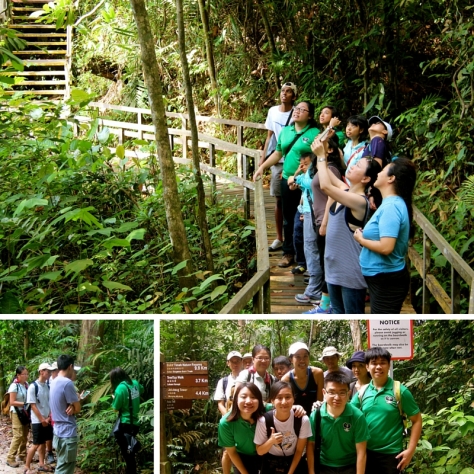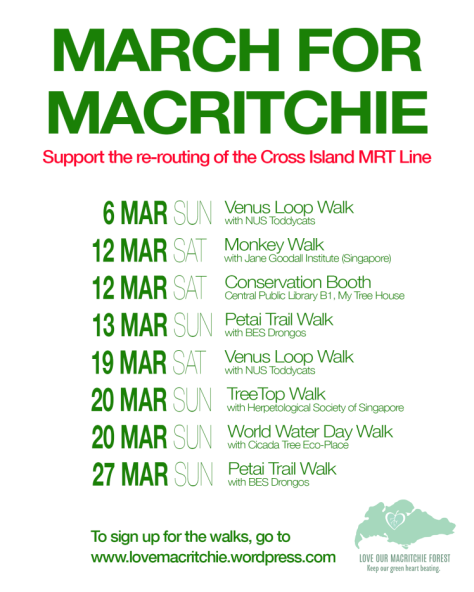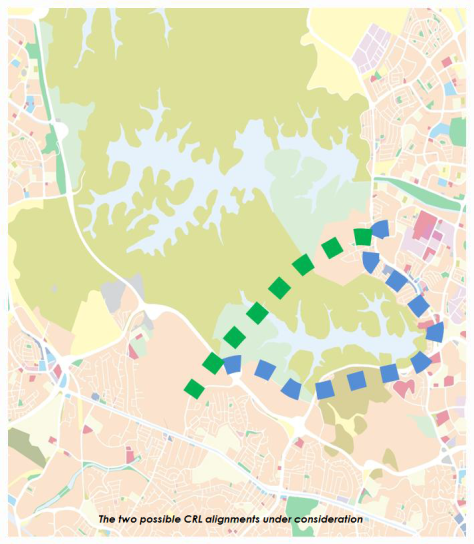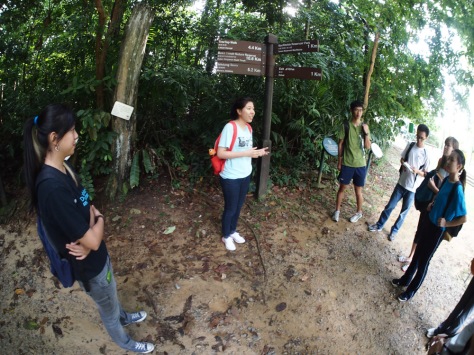It’s officially been the second year since we have begun this venture and it’s has been a great learning adventure. This semester has been especially wild with the media buzz surrounding the Cross Island Line and all the activities surrounding the March for MacRitchie campaign.
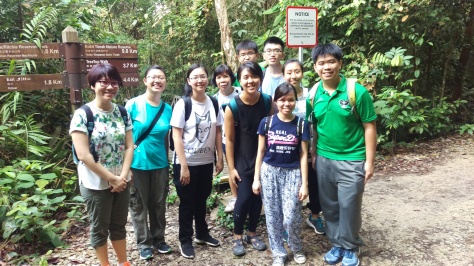
With seven exciting walks along the Petai Trail conducted this semester, we had a great time bringing participants along the Petai Trail and talk about the various inhabitants that share our nature reserve. From creepy-crawlies like the ferocious dragonfly to furry critters like the Slender Squirrel, there were much to explore in our nature reserve! Ecological concepts were also explored and explained using funny examples.

The leaf litter plant (Agrostistachys indica) or as we like to call it the kiasu plant, is used to explain the concept of an ecological niche. As an understory plant, it uses a different strategy to survive among the towering canopy trees you usually find in our tropical rainforest. Like us Kiasu Singaporeans, this clever little plant has found a way to survive in this competitive environment. It doesn’t just absorb nutrients from the nutrient-poor tropical soil but also from its leaves. How? With its leaves growing in a spiral, it is able to capture the leaves that fall from its taller neighbouring trees. Using the little rootlets growing on the base of its leaves, it can absorb the nutrients directly as these leaves decomposes [1]. Talking about getting the best of both worlds!
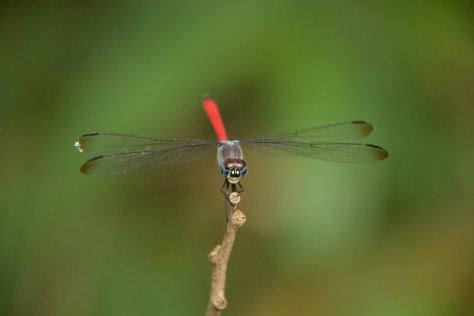
We also held conservation booths at the NUS campus. Lining up the wooden benches, we managed to display an even larger haul of preserved specimens loaned from the Lee Kong Chian Natural History Museum (Thanks again!). Cool jars filled with specimens hovering in ethanol, we were excited to share more about the species that were difficult to spot in the wild and less common to the public eye. The adorable but nocturnal Lesser Bamboo Bat is a prime example. Being one of the smallest bats, it grows only to about 4cm (the size of your thumb)! Usually found roosting in the hollow core of the bamboo, it’s not exactly the easiest creature to find [2].
Students, intrigued by creatures they don’t usually encounter, were eager to learn more about that flora and fauna we can find in our rainforest. Engaging with more than 250 students over those two days, it was encouraging to see the zest our generation had for nature. We hope that students left with a greater appreciation for our nature reserves and a deeper understanding on the Cross Island Line issue. We would like to thank all the participants who came down for our events and we hope that we have managed to incite some passion for our precious nature reserve!
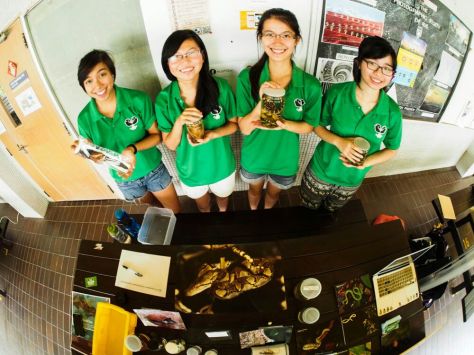
With the Cross Island Line still lingering at the back of the minds of Singaporeans, there have been many interesting articles that rationalise and reason out why we should conserve what’s left of Singapore’s wildlife. (While it can be argued that nature has no need for humans, that’s a story for another day.) Some might argue that we, nature lovers, tend to preach to the converted, those who are already passionate about the environment. So, here is a attempt to reach out to the stereotypical urban dweller who would rather hang out in a cool air-conditioned shopping mall than trek through the Central Catchment Nature Reserve (CCNR). Other than the intrinsic value of nature, what other benefits could be used to appeal to the ever-pragmatic Singaporean masses?
With thousands of visitors heading to CCNR annually, water sports and various other recreations activities make the nature reserve a brilliant outlet for stressed-out Singaporeans to take a break from the rat race of work. “Well, Singapore has over 300 parks [3].” you might point out, “I’m sure that there is an entire spectrum of alternative green areas for Singaporeans who want to enjoy fresh air.”

What about the ecosystem services that the CCNR provides? As the biggest continuous stretch of forest found in Singapore, it acts as the “green lungs” of our nation among various other valuable services.
“In comparison with the entire of Singapore,”you might object, “the CCNR constitutes a mere 4% of Singapore’s total land area. Does the ecosystem services it provides really make a difference to us?” Well, maybe it doesn’t make as much of an effect to the whole of Singapore but it certainly makes a difference for the residents (both animals and humans) who live near or within the CCNR.
Well, let’s bring up something that hasn’t really been touched upon: the wonder and awe that nature invokes. The natural environment has inspired humanity for centuries. From arts to architecture, natural wonders are so central to our culture and progress that almost every nation in the world has ideas and creations that reflect our awe of nature.

“Wait!” you might protest, “Art and all this airy fairy stuff might be very interesting but that won’t be able to fill our rice bowls.” Well, as the wise Robbie Williams once said, “medicine, law, business, engineering, these are noble pursuits and necessary to sustain life. But poetry, beauty, romance, love, these are what we stay alive for.” But I see your point.

To them, I say: industries have been built on nature. The Wright Brothers, who are widely credited for inventing the first aircraft capable of sustained flight and the father of the aviation industry, were inspired by the flight of pigeons [4]. You might remain unconvinced, after all biomimetics (field of study of designs inspired by nature) is a relatively new term. Has there really been that many innovations evoked from nature to justify saving our natural environment? Singapore’s uniform and ubiquitous HDB blocks resemble lego bricks more than they do rainforest trees.

But there is a whole plethora of nature-inspired products that can be found all around us. From the tiny pieces of velcro strapping across the white shoes of primary school students to the giant artificial “supertrees” towering over the Gardens by the Bay, there are numerous instances of innovations that have found inspiration from nature. This shouldn’t come as a surprise considering how all of us are successes of millions of years of continual R&D process, better known as evolution. We are all “products” that have been ruthlessly and relentlessly refined and prototyped.

To honour nature, the most experienced designer of us all, we will be releasing a new Nature and Technology series: Biomimicry, bringing the nature to you “innovations” of the forest. These posts will talk about creations that are inspired by the creatures we can find in our very own little island. Look forward to them!
P.S. (We will be conducting walks during the Summer! So, for all those who need a break from the urban jungle, join us at our natural one!)
- Wang LK, DCJ Yeo, KKP Lim & SKY Lum. (2012) Private Lives: An Expose of Singapore’s Rainforests. Raffles Museum of Biodiversity Research, Singapore. 298 pp.
- Baker, Nick. (n.d.). Bamboo Bats – Tylonycteris spp. Ecology Asia. Retrieved May 29, 2016, from http://www.ecologyasia.com/verts/bats/bamboo-bats.htm
- National Parks Boards (2015, January 5). Parks & Nature Reserves. Retrieved May 29, 2016, from https://www.nparks.gov.sg/gardens-parks-and-nature/parks-and-nature-reserves
- The Wright Brothers. (n.d.). Retrieved May 29, 2016, from http://airandspace.si.edu/exhibitions/wright-brothers/online/
Words by: Mel



